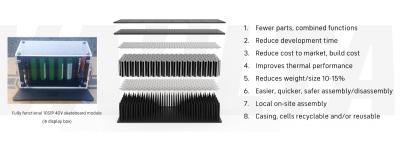Vaulta is an Australia-based startup that focuses on graphene-enhanced battery casings. Vaulta's director, Dominic Spooner, had a chat with the Graphene-Info team to help shed some light on this fascinating young company, it's technology and plans for the future.

Dominic has over 12 years’ experience as a design engineer and has worked in a wide range of industries including renewables and batteries, defense and aerospace, consumer products, commercial products and startups. He reveals that the idea for Vaulta came to him after working directly in the field of battery design and seeing an opportunity for growth that was largely being overlooked in favor of continuing with the status quo of battery module design. Dominic founded Ember Design House in 2017 undertaking general product from R&D to production and in 2019, he founded Vaulta to focus fully on the battery casing industry and turn his product ideas into reality.
Q. Can you give us a short introduction to Vaulta's technology and business?
A. Vaulta is a battery casing technology company based in Brisbane, Australia. Using advanced composite materials and smart, streamlined design, Vaulta has developed a lighter and smaller battery case with fewer parts, creating scalable efficiencies and opportunities for manufacturers.
Vaulta’s world-first no-weld design means modules can be easily assembled and disassembled, cells reused and recycled, and new cells added as battery technology continues to evolve.
From stationary storage and electric vehicles to defense, aerospace and beyond, Vaulta’s battery case technology works wherever batteries do.

Q. Are you already in production with your innovative battery casing? If so, in what capacity?
A. We are in the advanced prototyping phase with our product. A battery casing module developed for mass production is currently being tooled and will be available for testing and trials from around April 2021. We will be undergoing destructive testing soon, which we’re very much looking forward to.
Q. We understand that Vaulta adopts graphene in its casing to improve performance. Can you tell us in more detail how the graphene enhances the battery casing?
A. Heat is everything with batteries, and generally the most sensitive areas of a battery are the terminals. Using metals for current collection at the terminals and then plastics to house the batteries is the traditional method most often used to build a battery. By using graphene and other elements, we’ve separated thermal conductivity and electrical conductivity into two separate custom materials to allow a streamlined design that also works to remove heat from the cells directly at the terminals.
Q. Vaulta recently announced a deal with Aerospace developer QuickStep. Can you tell us a bit more about how the graphene casing will add value in the aerospace market?
A. Vaulta and Quickstep share common goals in a lot of ways. Quickstep specializes in composite, lightweight materials used for aerospace and defense. Vaulta is developing advanced battery casing technology that also uses composite, lightweight materials which makes us a natural fit. Working with Quickstep gives Vaulta an opportunity to break into markets that may not have been previously possible until we had become a more mature company. Vaulta’s technology also complements and strengthens Quickstep’s offering in these previously mentioned applications.
Q. Do you see other markets adopting graphene-enhanced battery casing? Will you target the EV market with your solutions?
A. Our ultimate goal is to become the new standard for how battery modules and packs are made. If this was to occur, we would see a sharp increase in second life battery applications and recycling figures better than just the 2-5% we see today. Stationary applications are our initial target. These companies can see the same benefits and can look to assemble their own modules meaning their costs can be greatly reduced. EVs will certainly be one of Vaulta’s targets, but not just land-based consumer vehicles. There are many applications that this technology can be used for before a roll-out into consumer vehicles.
Q. Can you tell us anything regarding the graphene material adopted by Vaulta and how is it being processed?
A. A lot of the work we’re doing with graphene will be ongoing, but what we can reveal is that the results are very promising and that graphene is very much usable for commercial real-world applications. It’s no longer the unicorn concept it once was.
Q. Where do you see your company in 3-5 years?
A. We see Vaulta’s battery casing technology being widely adopted and becoming the new standard. We hope to stand at the front of the battery recycling and reuse movement.